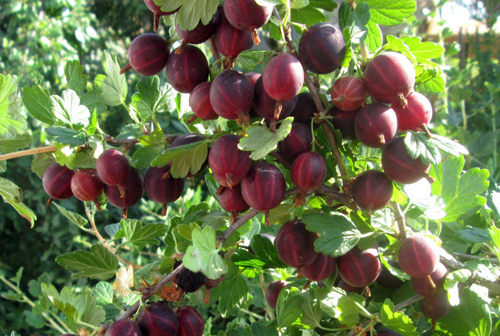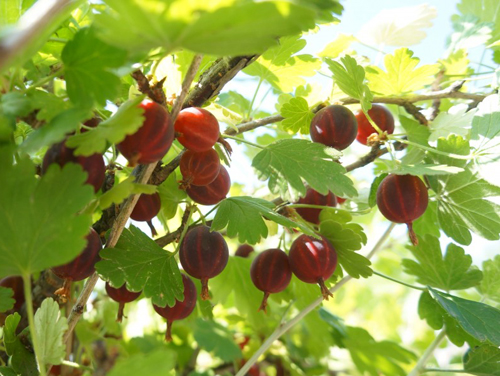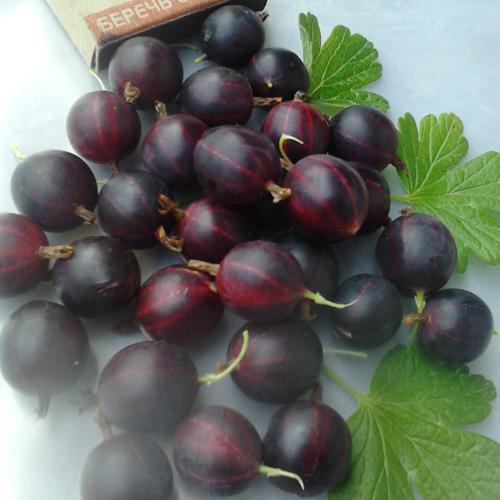Gooseberry variety Commander (Vladil)
To argue that prickly gooseberries are no longer relevant. Breeders have managed to breed varieties that are devoid of thorns, which means that when harvesting, you can do without scratches. One of such studless varieties is the Commander. It was created at the South Ural Research Institute of Horticulture and Potato Growing, located in Chelyabinsk. The parental forms (African and Chelyabinsk green) were crossed by V.S. Ilyin, to whom the authorship is assigned. The application for registration of the novelty was submitted in 1988. The variety was entered into the State Register of Breeding Achievements of the Russian Federation in 1995, but under a different name - Vladil (in honor of its creator). Regions of admission do not have a very favorable climate - North-West, Volgo-Vyatka, Middle Volga, Ural and West Siberian.

Description
The gooseberry bush is dense, it can be medium-sized or vigorous, the spreading is small, so the Commander looks compact. The shoots of the variety are upright, thin, green in color, anthocyanin coloration is present in the upper third of the shoots or up to half of it. Most of the shoots are thornless. In some places, light brown thorns are found thin or medium, growing singly. They are perpendicular to the shoot. The leaves are large, sometimes medium, dark green, with a shiny, slightly wrinkled surface. The leaf plate is five-lobed, sometimes three-lobed, straight or convex, on some leaves there is a concavity along the central vein. The base of the sheet has a slight indentation. The lobes are deep or moderately cut, the lateral lobes are shorter than the average. The lateral lobes are widely spaced, the angle between their midribs is often acute, less often straight. The denticles are not bent, large, with a blunt apex. The basal lobes are moderately developed. The petiole is of moderate length and thickness, light green, slightly pubescent. The buds of the variety are small, oblong, with a pointed tip, solitary, growing deviating from the shoot. The petiole trace is rounded or almost straight. Gooseberry flowers are small, brightly colored, bell-shaped, collected in two- or three-flowered inflorescences. The Commander's sepals are narrow and long, unclosed, red or pink in color, bent back. The pedicel is thin and long, not pubescent, green.
The berries are one-dimensional, round, with a thin skin that does not have pubescence, and a delicate consistency. The weight of fruits is 2.5 - 4.5 grams, the average weight of 2.8 grams is indicated in the State Register. Unripe berry is greenish-red, ripe berry is dark red, almost black. The cup is half-open. The peduncle is thin, long. The pulp is juicy, bright crimson. The taste is pleasant, memorable, sweet-sour with a slight astringency. The number of seeds is moderate, they are black in color. The tasting evaluation of the Commander berries, however, varies somewhat. According to the State Register, taste is estimated at 4.4 points, according to VNIISPK specialists - 4.9 points. Assessment of the appearance of the fruit - 4.4 points. 100 grams of raw mass contains: sugars - 13.1 - 14.4%, titrated acids - 2.2 - 3.0%, ascorbic acid - up to 54.8 mg.

Variety characteristics
- Gooseberries of medium early ripening. Flowering occurs in May, the harvest can be harvested in July, more precise timing depends on the climate and soil quality;
- flowers are highly resistant to spring frosts;
- the period of fruiting of the Commander is long;
- according to the State Register, the yield for 1992-1994 was 28.0 c / ha. According to information from VNIISPK, the average long-term yield is 10.0 t / ha, the maximum is 25.1 t / ha. Or from 3.0 to 7.5 kg per bush;
- the frost resistance of the variety is relatively high - up to -25 ° С;
- plant immunity is good, especially resistant to powdery mildew, at the level of standards it is affected by septoria and sawfly, weakly affected by anthracnose and fire;
- the culture is not inclined to shedding ripe fruits;
- gooseberries are characterized by good self-fertility - up to 48.2%;
- the transportability of the fruits is low - because of the thin skin, they do not withstand transportation, they wrinkle.If transportation cannot be avoided, try to pack the crop in small containers. Keeping quality is also a weak point of the Commander - it is advisable to eat or process the berries immediately;
- the way of using the fruits is universal. Gooseberries are good in their natural form, they are used to prepare raw jam, freeze, boil jam in combination with lemon, and process them into juice using a juicer.

Planting and leaving
Planting time depends on the climate. In warm regions, mild and humid autumn is suitable for this procedure, in cool regions - spring. The variety prefers soddy, soddy-podzolic or loamy soils with a loose structure. Areas with a high location of groundwater or often flooded should not be taken away for planting this crop, otherwise excessive moisture can cause the root system to die off. Gooseberries need to be protected from the prevailing winds, look for lighted and secluded places, but slightly ventilated. The culture is very responsive to feeding. Due to the increased thickening, the pruning procedure must be carried out annually - in the spring (before the leaves appear) or in the fall (after leaf fall). To rejuvenate and stimulate yields, branches older than 7 to 8 years are removed. Some gardeners tie the bush to a trellis to facilitate harvesting.
The Commander is an undemanding plant, but at the same time it is fruitful and very useful. Due to its good winter hardiness and resistance to diseases and pests, the variety quickly gained popularity. The absence of thorns and good taste make the gooseberry a favorite object for raids by children. But the variety also has disadvantages - the harvested crop will have to be processed as soon as possible, and the size of the fruits is not the greatest.








